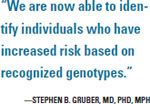Genetic variations influence statin efficacy for lowering colon cancer risk
Four years ago, at least five years of statin use was found to be associated with a 53% reduction in the risk of colorectal cancer and that association still stands, according to a coauthor of one of the initial studies to make the statin-cancer connection.
Four years ago, at least five years of statin use was found to be associated with a 53% reduction in the risk of colorectal cancer and that association still stands, according to a coauthor of one of the initial studies to make the statin-cancer connection.
Stephen B. Gruber, MD, PhD, MPH, and colleagues conducted the Molecular Epidemiology of Colorectal Cancer (MECC) study, a population-based casecontrol study of 1,953 colon cancer patients and 2,015 controls living in northern Israel between 1998 and 2004.
They found that the reduced relative risk of colorectal cancer with statins remained significant after adjustment for the use or nonuse of aspirin or other nonsteroidal anti-inflammatory drugs; the presence or absence of physical activity, hypercholesterolemia, and a family history of colorectal cancer; ethnic group; and level of vegetable consumption (N Engl J Med 352:2184-2192, 2005).
Looking at specific statins, the investigators found that both pravastatin (Pravachol) and simvastatin (Zocor) appeared to be associated with similar colorectal cancer protective effects and had very similar odds ratios: 0.45 for pravastatin and 0.47 for simvastatin, Dr. Gruber said at the 2009 American Society of Preventive Oncology meeting in Tampa, Fla. Dr. Gruber is a professor of internal medicine, epidemiology, and human genetics at the University of Michigan in Ann Arbor.

However, the use of fibric-acid derivatives, which have a pharmacology distinct from that of statins, was not associated with a significantly reduced risk of colorectal cancer, the study found. The fact that fibric-acid derivatives, despite lowering cholesterol, had no effect on colorectal cancer risk means that there might be something specific to the statins themselves, Dr. Gruber said.
"But does everyone achieve the same benefit from statins?" he asked. The earlier PRINCE trial (Pravastatin Inflammation CRP Evaluation) took on that question. The cardiovascular study was undertaken to determine if genetic variants in cholesterol metabolism were associated with different statin efficacies. The investigators found that in patients with the HMGCR haplotype the effi cacy of pravastatin in lowering cholesterol was reduced by 22%, "suggesting that certain genetic haplotypes contributed to worse lipid lowering and, as a result, worse cardiovascular outcomes," Dr. Gruber said (JAMA 286:64-70, 2001).
"So not everybody benefi ts equally from statins, and that is very important from the perspective of colon cancer prevention. Not everyone will benefi t to the same degree," he added.
Dr. Gruber and his colleagues genotyped the MECC study participants for variation within lipid metabolism genes using haplotype-tagging single-nucleotide polymorphisms (SNPs) to shed more light on whether pharmacogenetic variation in statin metabolism or cholesterol synthesis influences the risk of colorectal cancer.
When they looked at whether a variation of HMGCR by itself was associated with the risk of colorectal cancer, they found only a modest association between the variation and colorectal cancer risk.
They also found that two of six SNPs within HMGCR were signifi cantly associated with differential modifi cation of colorectal cancer risk by statins. Individuals with the A/A genotype for HMGCR who used statins had a relative risk of 0.33 for colorectal cancer compared with individuals with the T/T genotype who used statins. In those individuals, the relative risk of getting colorectal cancer was 0.66, Dr. Gruber said.
"Pharmacogenetic variation in HMGCR is associated with differences in the chemopreventive potential of statins to ward off colorectal cancer. This is where we start to be able to figure out which individuals will benefit the most from chemoprevention with statins," he said. "It's not just on the basis of family history or other risk factors. We are now able to identify individuals who have increased risk based on recognized genotypes. Epidemiologic methods will enable us to pinpoint those strategies which are likely to offer the greatest potential for chemoprevention by targeting specific populations."
Ultimately, this information will guide therapeutic decisions, he explained. The goal is to ensure that "we are offering the maximal benefit to those who will actually achieve it while minimizing the risks, something that is especially important in chemoprevention trials," he said.